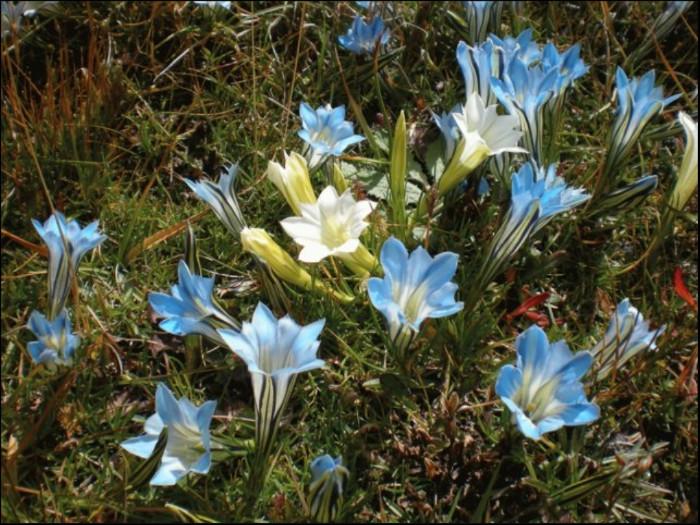Chinese Gentians - Part 2

A hint of the beauty that section ornatae holds was offered in the description and photo of gentiana futtereri - the large flowers coming in all shades of blue with prominent striping will rivet the attention of any garden visitor - blue has that ability to bewitch the viewer. The recent collections from Halda, Jurasek, Pavelka and Holubec have provided over 100 separate collections of ~ 40 different species. It's a daunting challenge to grow all of these, so some selection is necessary. However, like any obsession, the more I grew these, the more I wanted to grow them all.
It is a unique opportunity we have, right now. Given the rigours of seed collecting, a bounty such as this is rare. As Halda cogently said to me last year, "Keep these. You never know when they are available again." So, we value them all, and hope to make selections that will be worthwhile for the garden. The lack of lime sensitivity is perhaps the best characteristic seen so far. This important, for as Wilkie noted in, "Gentians" (published in 1935), " 'G. farreri is a good, hardy species and will flourish in a good garden soil free from lime. During the growing season it likes plenty of moisture below, and at all times open exposure and sunshine." - basically very good advice as to culture of gentians - rich soil and adequate moisture. The part about "lime free soil" we can now discard.
Halda related once how he brought back some plants of gentiana grandiflora from Siberia, rather rare in cultivation even for the Czechs. His mother, who insisted on fertilizing all of her gardens with rabbit manure, asked for a plant. He demurred and testily she said, "Give it to me and I will grow it." Of course he relented, and indeed, gentiana grandiflora did thrive in her garden. So, the following 3 will enjoy the richer soils of ordinary gardens. I would add, that from what I have seen of their growth habits, they will also appreciate an association with a low mat such as silene acaulis or, what I favour more, gypsophila aretiodes 'caucasica'. You will find that the adventitious shoots will hide in the protection of the mat. Photos in the wild, from China, show these gentians growing in meadow conditions. Halda describes flowering times of August - October, a rather broad season if you think about it. Of course what happens is the actual timing of the season in the wild, and now in the garden. This year may have been a bit more advanced than usual, but it seems that these gentians will bloom in mid - late summer; that is, from the limited number I have seen so far. I expect that more variation in flowering season will occur as we have more experience.
Gentiana lawrencei - A larger plant, with stems reaching to over 20 cm, The leaves are narrow and rather long (to 4 cm, dark green and tightly sheathing the stem. Flowers are found rising at the end of these branches, always single, but prominent. Total size will be ~ 5 cm long. Corolla will be greenish at its base, with 5 spreading bands of yellow and white and interspersed with light blue. The lobes vary from light to dark blue. This is a wide ranging species from Sichuan,Yunnan and Gansu to Tibet in the northwest. Of course it varies a lot and can be confused with similar species in the section; i.e.,g. helophila and g. sino-ornata. Plants named g. farreri are now considered to be part of this complex under g. lawrencei. Of course these new collections present the possibility of new selections and hybrids that are lime tolerant
G. sino-ornata - There are only a few collections of g. sino-ornata and I was hesitant to try them as the "traditional literature" states its aversion to limestone derived soils. One collection that caught my eye was from Jurasek and named only as an uncertain form of g. sino-ornata

Comments (0)
Add new comment